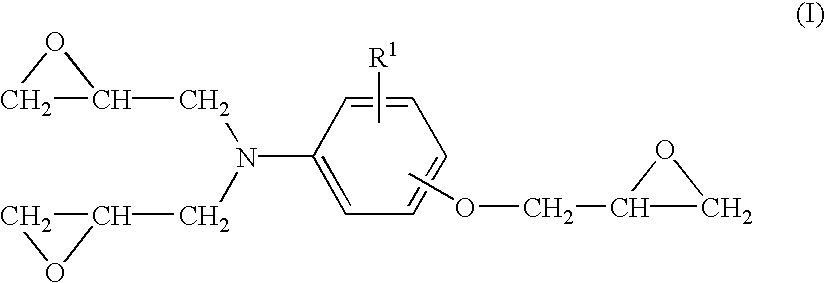Epoxy resin compositions, epoxy resin compositions for fiber-reinforced composite materials, and fiber-reinforced composite materials comprising the same
a technology of epoxy resin and composite materials, which is applied in the direction of synthetic resin layered products, yarn, transportation and packaging, etc., can solve the problems of increasing the viscosity of the resin, reducing the heat resistance and mechanical properties of the composite material, and reducing the product quality of the composite material. , to achieve the effect of improving the heat resistance and mechanical properties such as compressive strength
- Summary
- Abstract
- Description
- Claims
- Application Information
AI Technical Summary
Benefits of technology
Problems solved by technology
Method used
Image
Examples
example 1
EPIKOTE 630 was employed as an epoxy resin, and EPICURE W was employed as a curing agent and the viscosity of each material and the viscosity .eta..sub.5, .eta..sub.60, .eta..sub.120 and .eta..sub.240 after they were mixed were measured. Here, the mixing ratio (the ratio of the weight of the main agent to the weight of the curing agent, hereinafter referred to as mixing ratio R) was set to 0.464.
Then a cured resin plate was prepared according to the following procedure;
(1) raising the temperature of the composition at 1.5.degree. C. / min to 180.degree. C.,
(2) maintaining the temperature at 180.degree. C. for 120 minutes, and
(3) lowering the temperature at 2.5.degree. C. / min to 25.degree. C.
The obtained cured resin plate was subjected to the measurement for the glass transition point Tg and the tensile modulus of elasticity E.
example 2
EPIKOTE 630 was employed as an epoxy resin, and ANCAMINE 2049 was employed as a curing agent and the viscosity of each material and the viscosity of the resulting composition .eta..sub.5, .eta..sub.60, .eta..sub.120 and .eta..sub.240 after they were mixed were measured. Here, the mixing ratio R was set to 0.613.
Then a cured resin plate was prepared according to the following procedure;
(1) raising the temperature of the composition at 1.5.degree. C. / min to 60.degree. C.,
(2) maintaining the temperature at 60.degree. C. for 180 minutes,
(3) raising the temperature at 1.5.degree. C. / min to 180.degree. C.,
(4) maintaining the temperature at 180.degree. C. for 120 minutes, and
(5) lowering the temperature at 2.5.degree. C. / min to 25.degree. C.
The obtained cured resin plate was subjected to the measurement for the glass transition point Tg and the tensile modulus of elasticity E.
example 3
A mixture of 60 parts by weight of EPIKOTE 630 and 40 parts by weight of EPIKOTE 807 was employed as epoxy resins, and EPICURE W was employed as a curing agent and the viscosity of each material and the viscosity of the resulting composition .eta..sub.5, .eta..sub.60, .eta..sub.120 and .eta..sub.240 after they were mixed were measured. Here, the mixing ratio R was set to 0.384.
Then a cured resin plate was prepared according to the procedure similar to that used in Example 1. The obtained cured resin plate was subjected to the measurement for the glass transition point Tg and the tensile modulus of elasticity E.
PUM
| Property | Measurement | Unit |
|---|---|---|
| Temperature | aaaaa | aaaaa |
| Percent by mass | aaaaa | aaaaa |
| Pressure | aaaaa | aaaaa |
Abstract
Description
Claims
Application Information
 Login to View More
Login to View More - R&D
- Intellectual Property
- Life Sciences
- Materials
- Tech Scout
- Unparalleled Data Quality
- Higher Quality Content
- 60% Fewer Hallucinations
Browse by: Latest US Patents, China's latest patents, Technical Efficacy Thesaurus, Application Domain, Technology Topic, Popular Technical Reports.
© 2025 PatSnap. All rights reserved.Legal|Privacy policy|Modern Slavery Act Transparency Statement|Sitemap|About US| Contact US: help@patsnap.com



